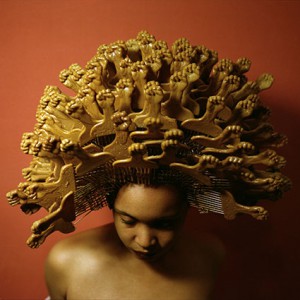Reprinted from the KaKY (Kollege and Kareer 4 Youth) blog with permission from Marcy Williams, MBA

Pickin’, 2007, Lauren Kelly (American, born 1975), color-coupler print, 23 x 23 1/8 in.
The exploration of beauty in the African American culture has been explored for centuries. From the earliest days of slavery to the most recent neo-soul era, the topic of what is considered beauty in the African American culture has continued to be a multifaceted and controversial topic with no clear sign of resolution. Big lips, large hips, skin dark as the black sand beaches of Hawaii to skin as bright as the clouds that hang above, beauty comes in all shapes, sizes and colors. For the youth of today, the thought of what is considered beautiful has played a huge role in how they view themselves according the standards dictated by society. In fact, media, movies, videos and even commercials play such a large role in how youth see themselves and that the epidemic of self-hate has increased to being that of low self-esteem. However, the concept of art as it relates to beauty is often left unnoticed and therefore underutilized.
During my recent visit to the Posing Beauty in African American Culture exhibit at the Virginia Museum of Fine Arts, I took along some youth to get their perspective on the art and more importantly how they interpreted the pieces as it relates to beauty in African American culture. In the early 1960’s, the ideologies of Dr. Martin Luther King, Jr were in the early phases of creating a brotherhood for all Americans regardless of race, color or creed. According to one viewpoint of Young Men on 42nd Street it was stated “it looks like these two young men are together when really the African American boy looks like he is being forced to take the picture” stating Trinity Smith. “He’s clearly not happy because maybe he’s thinking about how he has to go back to his poor family at home”.
While Posing Beauty in African American Culture dares to examine the ways in which African American beauty is displayed, it also speaks to the cultural challenges faced by a race at different times in history. Through its various forms of media including paintings, sculptures, photographs and videos, this exhibit provides a diverse and contextual look into the beauty of the African American Culture from a variety of artists and collections. Posing Beauty features approximately 90 works by artists such as Carrie Mae Weems, Charles “Teenie” Harris, Eve Arnold, Gary Winogrand, Sheila Pree Bright, Leonard Freed, Renee Cox, Anthony Barboza, Bruce Davidson, Mickalene Thomas, and Jeanne Moutoussamy-Ashe, this exhibit brings to life the beauty of the African American Culture.
Maya Criss (age 14) stated, Young Man in Plaid by Jeffrey Henson Scales looks like he does not care about what anyone is thinking, he is happy with his own style and that’s the way it should be – I wish all youth could be themselves and not worry about being bullied or peer pressured.”
The most captivating photograph was Karisse. Of all the works of art, this seemed to capture everyone’s attention. The sullenness of her face along with the freckles touched the group in a way that left them excited about natural beauty. The cultural influences affect a young person’s body image, attitude and behavior and can determine the way in which they structure their lives in the future. What is considered traditional beauty can be argued by this photo as the beauty of the broad nose, freckles and natural hue reminds us that true beauty lies beneath the glitz and glam of society’s perspective and is simply put “just the way we are supposed to be.”
In summary, it will be interesting to how the ideals portrayed in the Posing Beauty exhibit impact how young people begin to view beauty going forward. While mainstream society plays an integral part in the way in which youth view beauty, the presence of different perspective and understanding that beauty is in the eye of the beholder can make a huge impact in the lives of youth.